CHEVROLET TRACKER 1997 Owners Manual
Manufacturer: CHEVROLET, Model Year: 1997, Model line: TRACKER, Model: CHEVROLET TRACKER 1997Pages: 388, PDF Size: 20.12 MB
Page 241 of 388
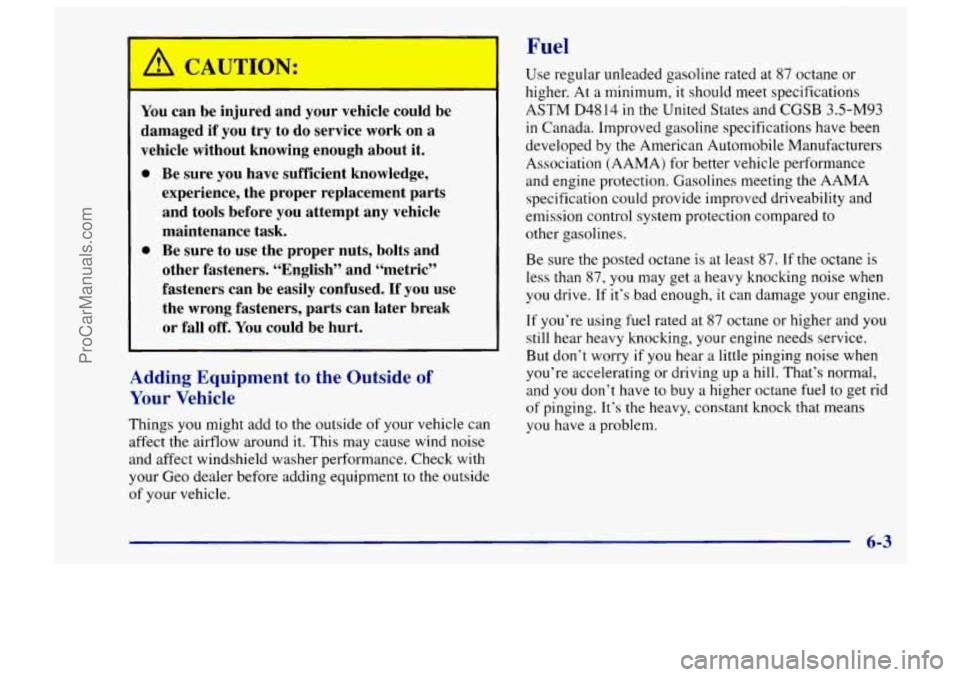
I
A CAUTION:
You can be injured and your vehicle could be
damaged if you
try to do service work on a
vehicle without knowing enough about it.
0
0 Be sure you have sufficient knowledge,
experience, the proper replacement parts
and tools before you attempt any vehicle
maintenance task.
Be sure to use the proper nuts, bolts and
other fasteners. “English” and “metric”
fasteners can be easily confused.
If you use
the wrong fasteners, parts can later break
or fall off. You could be hurt.
Adding Equipment to the Outside of
Your Vehicle
Things you might add to the outside of your vehicle can
affect the airflow around it. This may cause wind noise
and affect windshield washer performance. Check with
your Geo dealer before adding equipment to the outside
of your vehicle.
Fuel
Use regular unleaded gasoline rated at 87 octane or
higher.
At a minimum, it should meet specifications
ASTM
D4814 in the United States and CGSB 3.5-M93
in Canada. Improved gasoline specifications have been
developed by
the American Automobile Manufacturers
Association (AAMA) for better vehicle performance
and engine protection. Gasolines meeting the AAMA
specification could provide improved driveability and
emission control system protection compared to other gasolines.
Be sure the posted octane
is at least 87. If the octane is
less than 87,
you may get a heavy knocking noise when
you drive. If it’s bad enough, it can damage your engine.
If you’re using fuel rated at
87 octane or higher and you
still hear heavy knocking, your engine needs service.
But don’t worry if you hear a little pinging noise when
you’re accelerating or driving up
a hill. That’s normal,
and you don’t have to buy a higher octane fuel to get rid
of pinging. It’s the heavy, constant knock that means
you have a problem.
6-3
ProCarManuals.com
Page 242 of 388
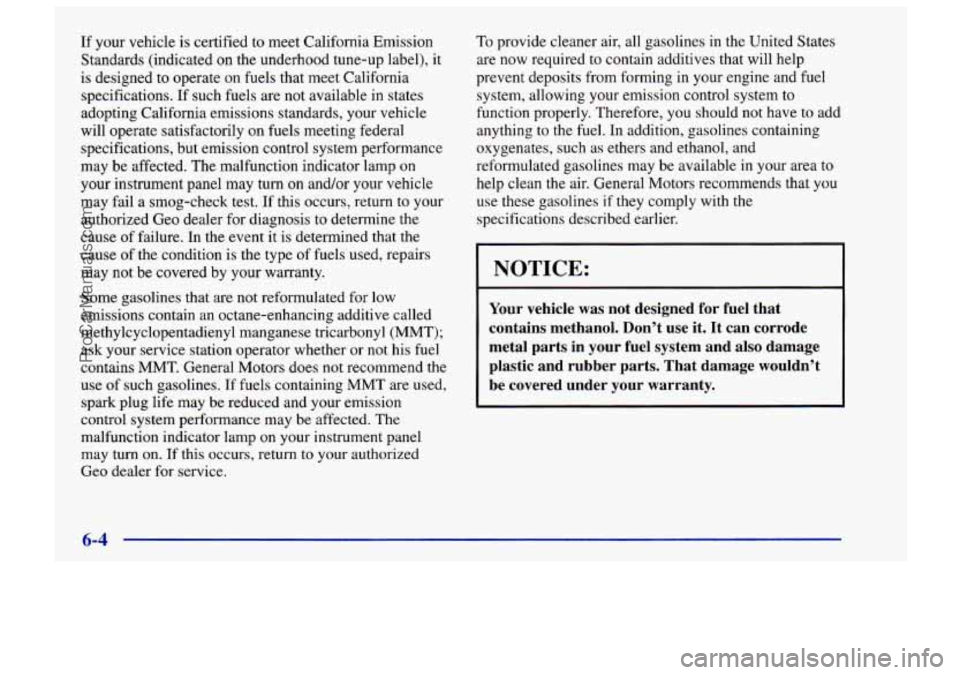
If your vehicle is certified to meet California Emission
Standards (indicated on the underhood tune-up label), it
is designed to operate on fuels that meet California
specifications. If such fuels are not available in states
adopting California emissions standards, your vehicle
will operate satisfactorily on fuels meeting federal
specifications, but emission control system performance
may be affected. The malfunction indicator lamp on
your instrument panel may turn
on and/or your vehicle
may fail
a smog-check test. If this occurs, return to your
authorized Geo dealer for diagnosis to determine the
cause
of failure. In the event it is determined that the
cause
of the condition is the type of fuels used, repairs
may
not be covered by your warranty.
Some gasolines that are not reformulated for low
emissions contain an octane-enhancing additive called
methylcyclopentadienyl manganese tricarbonyl (MMT);
ask your service station operator whether or not his
fuel
contains MMT. General Motors does not recommend the
use of such gasolines.
If fuels containing MMT are used,
spark plug life may be reduced and your emission
control system performance may be affected. The
malfunction indicator lamp on your instrument panel
may
turn on. If this occurs, return to your authorized
Geo dealer for service. To
provide cleaner air, all gasolines in the United States
are now required to contain additives that will help
prevent deposits from forming in your engine and fuel
system, allowing your emission control system
to
function properly. Therefore, you should not have to add
anything to the fuel. In addition, gasolines containing
oxygenates, such
as ethers and ethanol, and
reformulated gasolines may be available in your area to
help clean the air. General Motors recommends that you
use these gasolines if they comply with the
specifications described earlier.
NOTICE:
Your vehicle was not designed for fuel that
contains methanol. Don’t use it. It can corrode
metal parts in your fuel system and also damage
plastic and rubber parts. That damage wouldn’t
be covered under your warranty.
6-4
ProCarManuals.com
Page 243 of 388
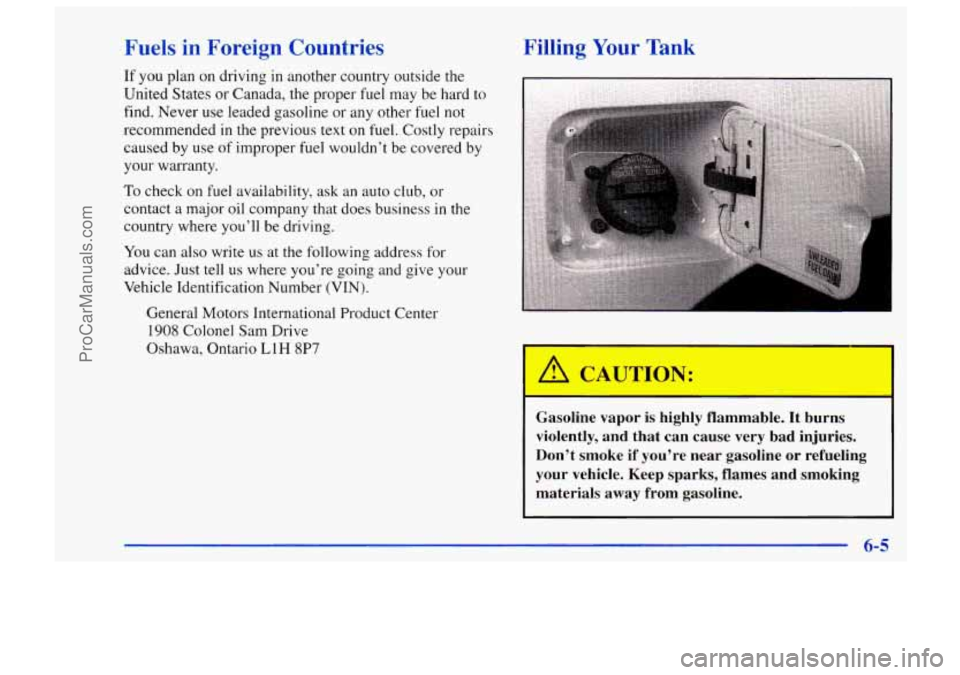
Fuels in Foreign Countries
If you plan on driving in another country outside the
United States
or Canada, the proper fuel may be hard to
find. Never use leaded gasoline or any other fuel not
recommended in the previous text on fuel. Costly repairs
caused by use of improper fuel wouldn’t be covered by
your warranty.
To check on fuel availability, ask an auto club, or
contact a major
oil company that does business in the
country where you’ll
be driving.
You can also write
us at the following address for
advice. Just tell
us where you’re going and give your
Vehicle Identification Number (VIN).
General Motors International Product Center
1908 Colonel Sam Drive
Oshawa, Ontario
LlH 8P7
Filling Your Tank
W
Gasoline vapor is highly flammable. It burns
violently, and that can cause very bad injuries.
Don’t smoke if you’re near gasoline
or refueling
your vehicle. Keep sparks, flames and smoking materials away
from gasoline.
6-5
ProCarManuals.com
Page 244 of 388
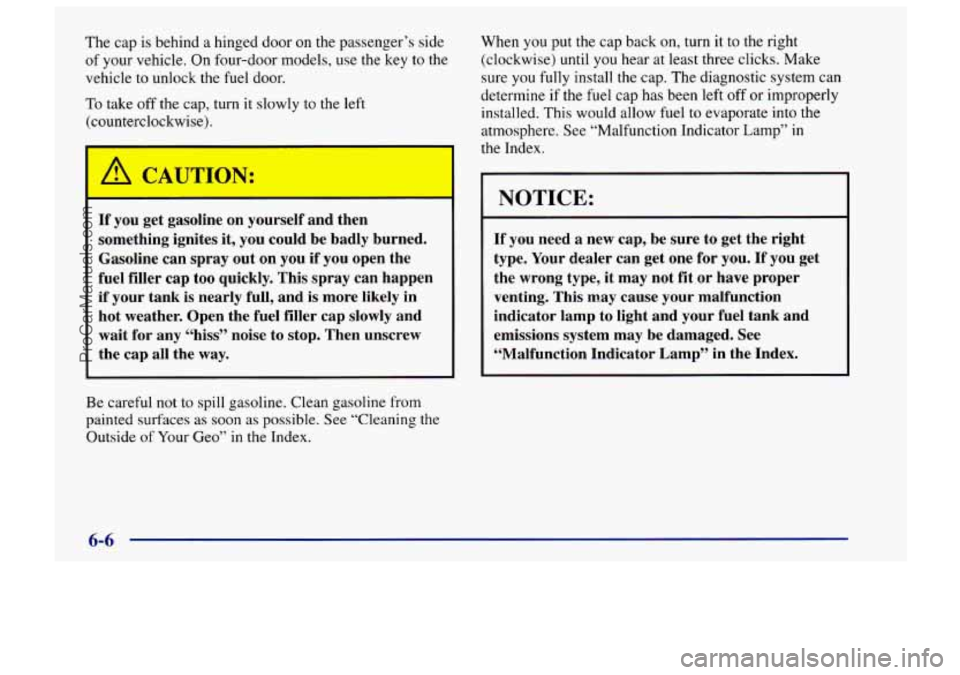
The cap is behind a hinged door on the passenger’s side
of your vehicle. On four-door models, use the key to the
vehicle to unlock the
fuel door.
To take off the cap, turn it slowly
to the left
(counterclockwise).
1 /1 CAUTION:
If you get gasoline on yourself and then
something ignites it, you could be badly burned.
Gasoline can spray out on you
if you open the
fuel filler cap
too quickly. This spray can happen
if your tank is nearly full, and is more likely in
hot weather. Open the fuel filler cap slowly and
wait for any “hiss” noise
to stop. Then unscrew
the cap all the
way.
Be careful not to spill gasoline. Clean gasoline from
painted surfaces
as soon as possible. See “Cleaning the
Outside of Your Geo”
in the Index. When you
put the cap back on, turn it to the right
(clockwise)
until you hear at least three clicks. Make
sure you
fully install the cap. The diagnostic system can
determine
if the fuel cap has been left off or improperly
installed. This would allow fuel to evaporate into the
atmosphere. See “Malfunction Indicator Lamp”
in
the Index.
I
NOTICE:
If you need a new cap, be sure to get the right
type. Your dealer can get one for you. If you get
the wrong type, it may not fit or have proper
venting. This may cause
your malfunction
indicator lamp to light and your fuel tank and
emissions system may be damaged. See
“Malfunction Indicator Lamp” in the Index.
6-6
ProCarManuals.com
Page 245 of 388

Checking Things Under the Hood
An electric fan under the hood can start up and
injure you even when the engine is not running.
Keep hands, clothing and tools away from any
underhood electric fan. Don’t reach through the
grille to release the underhood lever.
Things that burn can get on hot engine parts and
start a fire. These include liquids like gasoline,
oil, coolant, brake fluid, windshield washer and
other fluids, and plastic or rubber. You or others
could be burned. Be careful not to drop or spill
things that
will burn onto a hot engine.
TO open the hood, first pull the release handle inside the
glove box.
6-7
ProCarManuals.com
Page 246 of 388
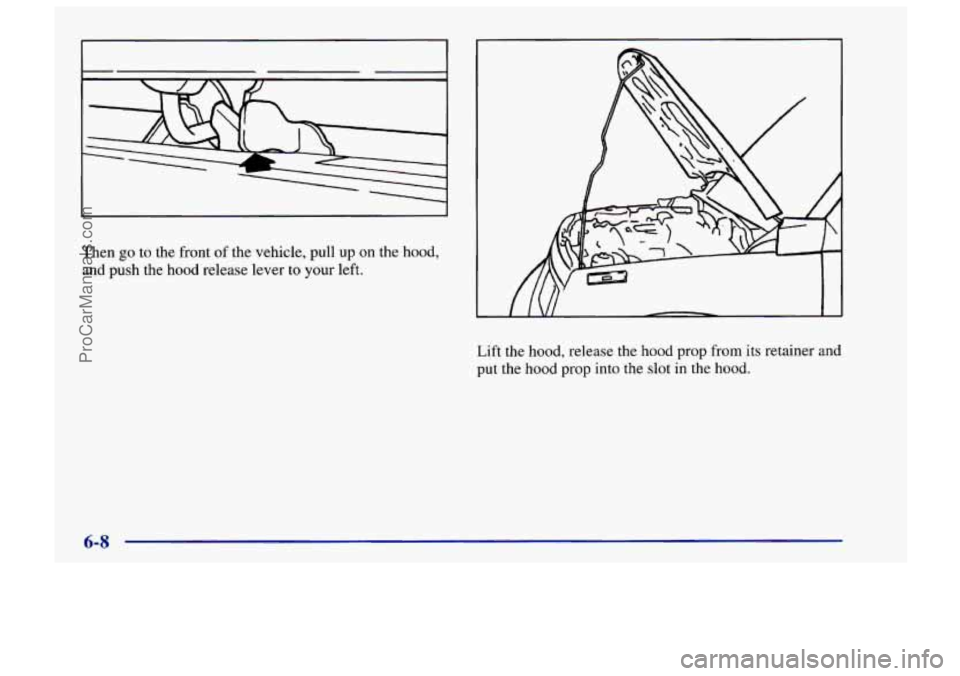
I I
Then go to the front of the vehicle, pull up on the hood,
and push the hood release lever
to your left.
Lift the hood, release the hood prop from its retainer and
put the hood prop
into the slot in the hood.
6-8
ProCarManuals.com
Page 247 of 388
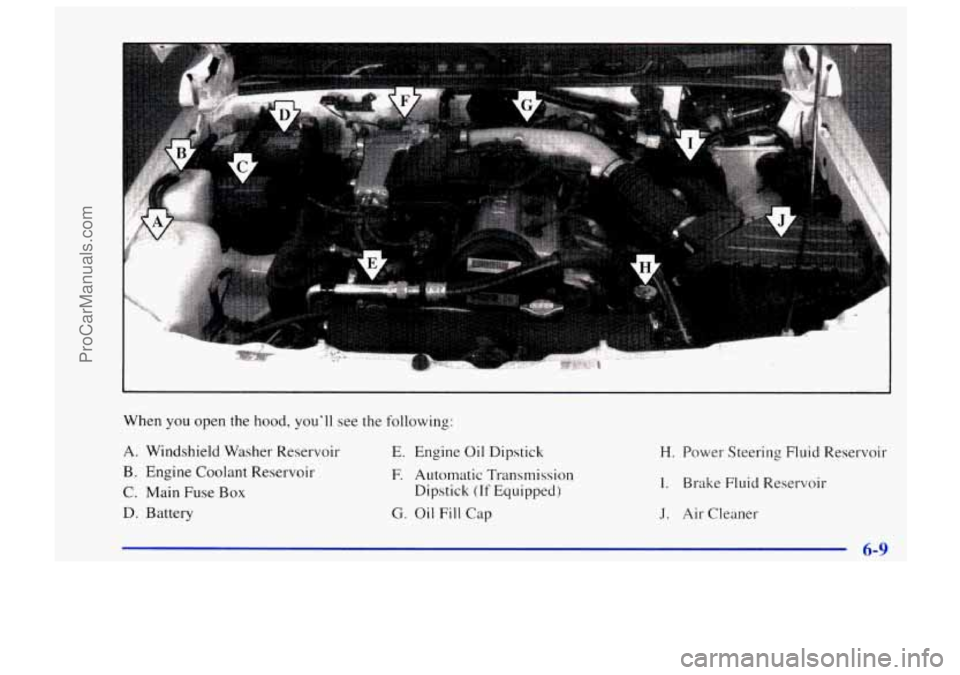
J
When you open the hood, you’ll see the following:
A. Windshield Washer Reservoir
B. Engine Coolant Reservoir
C. Main Fuse Box
D. Battery
E. Engine Oil Dipstick
F. Automatic Transmission
Dipstick
(If Equipped)
G. Oil Fill Cap
H. Power Steering Fluid Reservoir
I. Brake Fluid Reservoir
J. Air Cleaner
6-9
ProCarManuals.com
Page 248 of 388
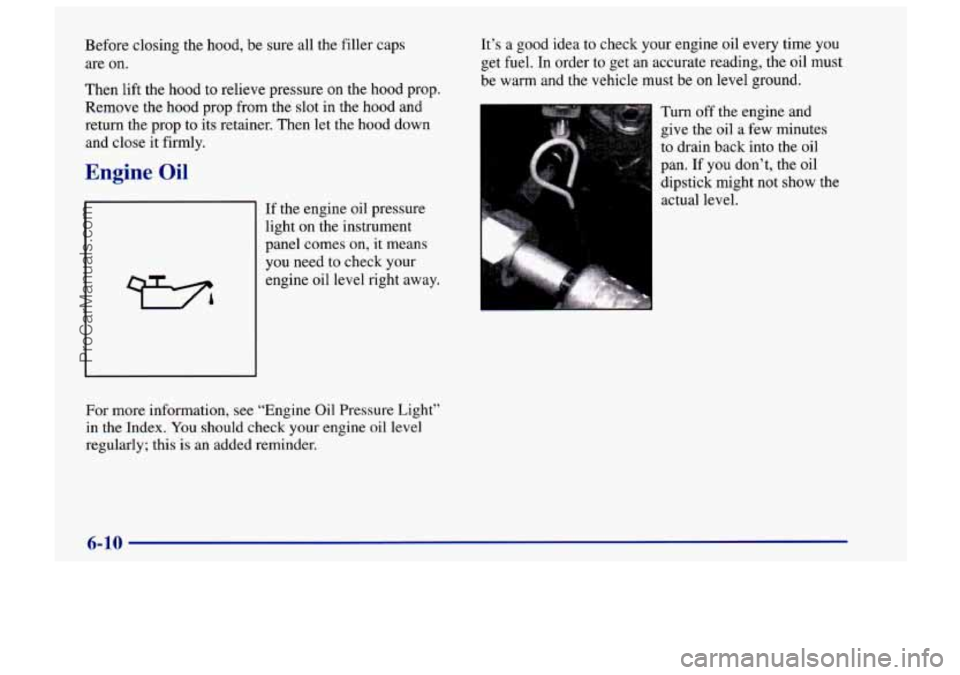
Before closing the hood, be sure all the filler caps
are on.
Then lift the hood to relieve pressure
on the hood prop.
Remove the hood prop from the slot in the hood and
return the prop to its retainer. Then let the hood down
and close it firmly.
Engine Oil
If the engine oil pressure
light
on the instrument
panel comes on, it means
you need to check your
engine oil
level right away.
For more information, see “Engine Oil Pressure Light”
in the Index. You should check your engine oil level
regularly; this is an added reminder. It’s
a good idea
to check your engine oil every time you
get fuel. In order
to get an accurate reading, the oil must
be warm and
the vehicle must be on level ground.
Turn off the engine and
give the oil a few minutes
to drain back into the oil
pan. If
you don’t, the oil
dipstick might not show the
actual level.
6-10
ProCarManuals.com
Page 249 of 388
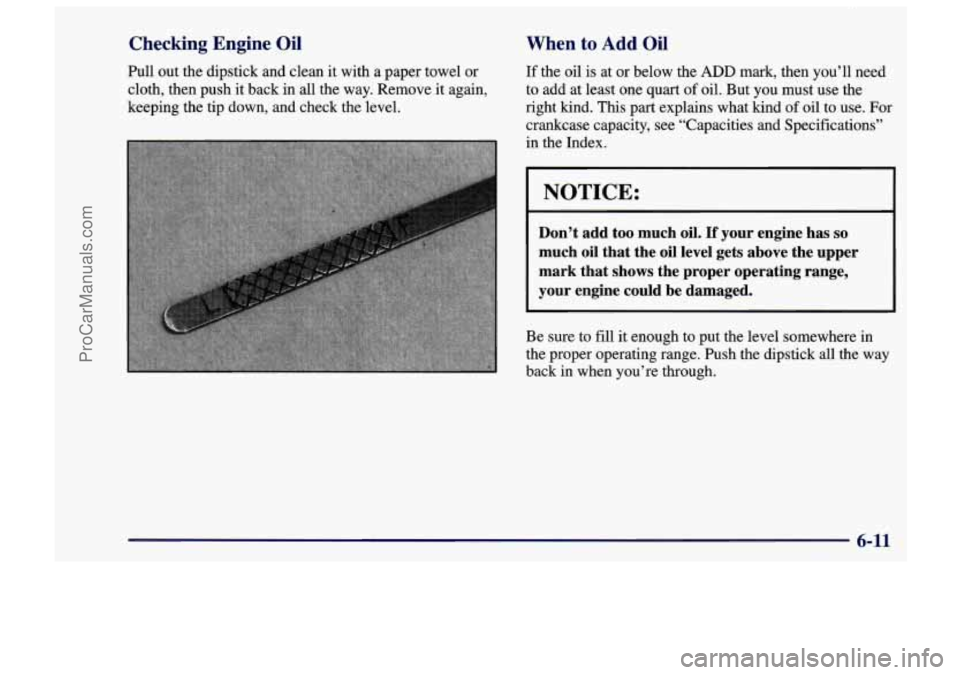
Checking Engine Oil
Pull out the dipstick and clean it with a paper towel or
cloth, then push it back in
all the way. Remove it again,
keeping the tip down, and check the level.
When to Add Oil
If the oil is at or below the ADD mark, then you’ll need
to add at least one quart of oil. But you must use the
right kind.
This part explains what kind of oil to use. For
crankcase capacity, see “Capacities and Specifications’’
in the Index.
I NOTICE:
Don’t add too much oil. If your engine has so
much oil that the oil level gets above the upper
mark that
shows the proper operating range,
your engine could be damaged.
Be sure to fill it enough to put the level somewhere in
the proper operating range. Push the dipstick all the way
back
in when you’re through.
6-11
ProCarManuals.com
Page 250 of 388
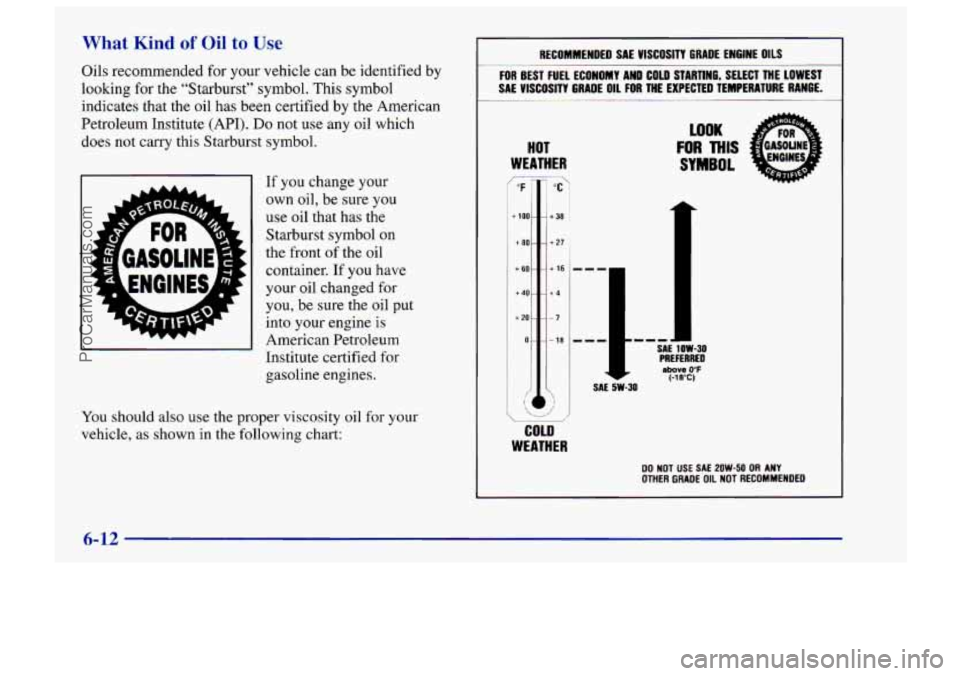
What Kind of Oil to Use
Oils recommended for your vehicle can be identified by
looking for the “Starburst” symbol. This symbol
indicates that the oil has been certified by the American
Petroleum Institute (API).
Do not use any oil which
does not carry this Starburst symbol.
I:
If you change your
own oil, be sure you
use oil that has the
Starburst symbol on
the front of the oil
container. If you have
your oil changed for
you, be sure the oil put
into your engine is
American Petroleum
I J
Institute certified for
gasoline engines.
~~~ ~~~~~~
You should also use the proper viscosity oil for your
vehicle, as shown in the following chart:
RECOMMENDED SAE VISCOSITY GRADE ENGINE OILS
FOR BEST FUEL ECONOMY AND COLD STARTING, SELECT THE LOWEST
SAE VISCOSITY GRADE OIL
FOR THE EXPECTED TEMPERATURE RANGE. -
HOT
WEATHER
“F
t 100
+ ao
+ 60
+ 40.
+ 20.
0-
t3a ~
+ 27
+ 16
t4
-7
- 18
SAE 5W-30
LOOK
FOR MIS
SYMBOL
above 0°F (’1 WC)
WEATHER
00 NOT USE SAE 2OW-50 OR ANY OTHER GRADE OIL NOT RECOMMENDED
6-12
ProCarManuals.com